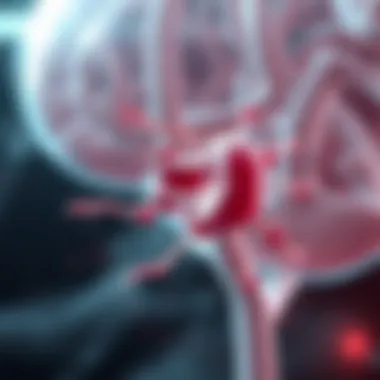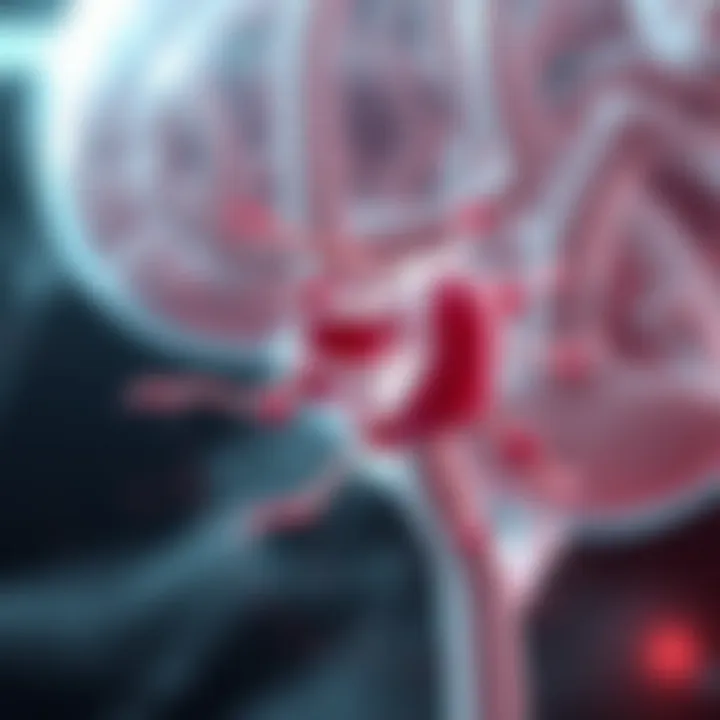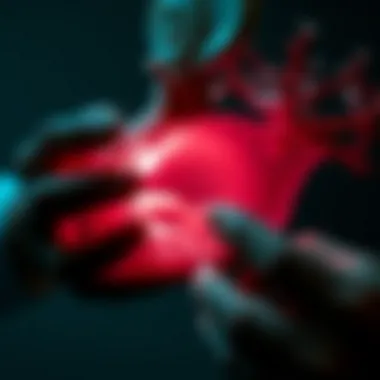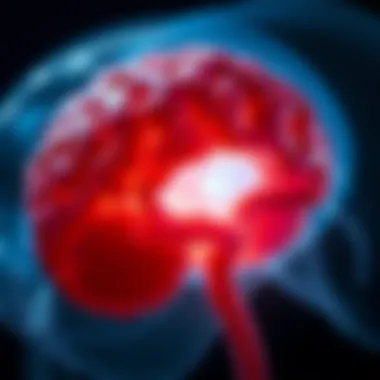Understanding Pseudoaneurysms: A Detailed Overview


Intro
In the realm of vascular anomalies, pseudoaneurysms stand out as particularly puzzling and often misunderstood entities. While they share certain characteristics with true aneurysms, their underlying mechanisms and clinical ramifications paint a far more complex picture. A pseudoaneurysm arises when blood escapes from the arterial lumen but is contained by the surrounding tissues rather than a true vascular wall, leading to a sac-like structure that can provoke significant concern.
The topic is highly relevant given the rising incidence of vascular interventions and the complexity involved in accurately diagnosing and treating these anomalies. Physicians and healthcare providers often grapple with differentiating between a pseudoaneurysm and a true aneurysm because both conditions exhibit similar clinical features, making the precise diagnosis crucial for effective management.
Understanding the pathophysiology of pseudoaneurysms is essential for healthcare professionals, as it lays the groundwork for subsequent diagnostic efforts and treatment decisions. Moreover, knowledge of risk factors such as trauma, surgery, or pre-existing vascular conditions is vital in aiding the preventative and therapeutic strategies employed.
In this article, we will journey through the intricacies of pseudoaneurysms, covering everything from their formation to the latest advancements in treatment options. This exploration aims to arm both students and seasoned practitioners with an enriched understanding, thus elevating their approach toward a condition that continues to challenge conventional vascular medicine.
Foreword to Pseudoaneurysms
Understanding pseudoaneurysms is crucial for healthcare professionals, as these vascular anomalies can mimic true aneurysms, leading to misdiagnosis and improper treatment. By delving into the characteristics of pseudoaneurysms and their clinical implications, we begin to grasp not only their medical significance but also their potential impact on patient care. Accurately distinguishing between pseudoaneurysms and other vascular conditions is essential for achieving optimal outcomes for patients, making it a topic worthy of thorough examination. Additionally, the study of pseudoaneurysms encompasses a range of factors, from vascular physiology to innovative imaging techniques that enhance diagnostics and foster better management strategies.
Defining Pseudoaneurysms
A pseudoaneurysm, often confused with a true aneurysm, is a localized disruption in the vascular wall that leads to an outpouching or bulging. Unlike true aneurysms that involve all three layers of the arterial wall, pseudoaneurysms occur when blood breaches the vessel wall but remains contained by surrounding tissue or a hematoma. This breach often arises from trauma, surgical complications, or infectious processes. In essence, a pseudoaneurysm represents a breach that has the potential to rupture, hence raising significant clinical concerns.
In terms of diagnosis, pseudoaneurysms can manifest as palpable masses or may present without symptoms until complications arise. Recognition of these lesions is vital, as their management requires a nuanced understanding of their underlying pathophysiology and the unique context of each patient. Therefore, when we talk about defining pseudoaneurysms, we're not just identifying a condition; we're emphasizing the importance of accurate clinical assessment in promoting patient safety.
Historical Context
The concept of pseudoaneurysms is not a modern invention. Historically, descriptions of vascular lesions resembling pseudoaneurysms can be traced back to the work of early anatomists and surgeons. For example, the intricate studies of 17th-century physicians began to outline the differences between true aneurysms and those that did not conform to the classical descriptions. Over the years, advancements in imaging and greater understanding of vascular pathology enhanced the recognition of pseudoaneurysms.
In the 19th century, heightened surgical practices during the era of war led to an increase in vascular injuries, which in turn raised awareness of vascular anomalies, including pseudoaneurysms. Surgeons began to better understand the implications of these structures, especially following traumatic injuries. Even in more recent decades, as minimally invasive techniques have gained popularity, the awareness and diagnosis of pseudoaneurysms have evolved, reflecting an ongoing journey of discovery and understanding.
Anatomy of Vascular Structures
Understanding the anatomy of vascular structures plays a pivotal role in dissecting the intricacies of pseudoaneurysms. These abnormal vascular formations hinge on the delicate interplay between the structural integrity of blood vessels and the forces that act upon them. Grasping the anatomy ensures clinicians effectively diagnose and implement appropriate management strategies for vascular anomalies, enriching patient outcomes.
Overview of Blood Vessels
Blood vessels are the highways of the body, acting as conduits for the transportation of blood, nutrients, and oxygen. They come in three main types: arteries, veins, and capillaries.
- Arteries are robust, muscular tubes that carry oxygen-rich blood away from the heart to the rest of the body. Their thick walls accommodate high-pressure blood flow, ensuring adequate delivery to tissues. A classic example of a significant artery is the aorta, which branches out into smaller arteries, spreading throughout the body.
- Veins, on the other hand, are less muscular and more flexible. They return deoxygenated blood back to the heart, often working against gravity. Take the jugular veins, which drain blood from the head back to the heart, as a prime illustration of a functionally important venous pathway.
- Capillaries are minuscule vessels that form a network between arteries and veins. They are where much of the exchange of gases, nutrients, and waste products occurs, so their structure and function are fundamental to maintaining homeostasis within the body. Their walls are so thin that only one blood cell can pass through at a time.
Overall, a comprehensive understanding of these specialized structures allows medical professionals to better appreciate how disruptions—like those that lead to pseudoaneurysms—can arise.
Pathophysiology of Vessel Damage
When it comes to the development of pseudoaneurysms, the underlying pathophysiology often points to damage sustained by the vascular walls. A breakdown in this intricate structure leads to abnormal blood flow dynamics and potential vessel leakage.
Several factors that contribute to vessel damage include:
- Trauma: External forces can damage the vascular wall, leading to a breach that can allow blood to escape into surrounding tissues. This is often seen in cases involving blunt force or penetrating injuries.
- Disease: Conditions like atherosclerosis weaken arteries as plaque builds up, making them susceptible to rupture or distortion.
- Infection: Certain infections can erode vascular walls, compounding the risk for pseudoaneurysms. As seen with infective endocarditis, the heart valve infection can lead to vascular complications.
- Surgical Procedures: Even well-performed procedures can lead to inadvertent damage, for instance in patients undergoing catheterization or various vascular surgeries, where tools inadvertently affect vessel integrity.
“Understanding vessel damage is not just about knowing the mechanics; it’s about grasping the implications these disruptions have on overall health.”
In essence, dissecting the anatomy of vascular structures equips practitioners to identify potential risks and manage complications. A thorough grasp of these topics lays the foundation for effective patient care related to pseudoaneurysms.
Mechanisms Behind Pseudoaneurysm Formation
Understanding the mechanisms that contribute to pseudoaneurysm formation is essential in grasping how these vascular anomalies develop. Their significance in medical practice cannot be overstated, impacting both diagnosis and treatment strategies. Recognizing the underlying causes helps healthcare professionals anticipate complications and engage in more effective management protocols. In this section, we will delve into three primary catalysts: trauma and vascular injury, surgical complications, and infectious causes.
Trauma and Vascular Injury
Trauma is one of the predominant contributors to pseudoaneurysms. It can arise from blunt force impacts, penetrating injuries, or even less obvious causes like repetitive strain over time. The mechanisms at play involve breaches or disruptions in the vessel wall, leading to the formation of a hematoma that can evolve into a false aneurysm.
In cases of blunt injury, such as those sustained in car accidents, the impact can result in a dissection of the arterial layers. This is not just a superficial problem; damage extends deep into the vessel wall, compromising its integrity. As the body works to repair the site, the resultant hematoma can become encapsulated, forming the characteristic structure of a pseudoaneurysm.
Additionally, case studies show that injuries from high-speed accidents have higher associations with complex pseudoaneurysms, necessitating advanced imaging for diagnosis. Remember, even seemingly minor traumas can precipitate this condition, leading to critical vascular issues if left unaddressed.
"Injuries not only affect the external anatomy but can also trigger profound internal changes that may go unrecognized at first."
Surgical Complications
The surgical realm is rife with complications that can lead to the formation of pseudoaneurysms. Procedures involving manipulations of blood vessels, particularly those in vascular surgery or cardiac interventions, inherently carry risks. For instance, catheter-based procedures can inadvertently damage the vessel wall, making patients vulnerable to developing a pseudoaneurysm in the post-operative phase.
Suturing techniques and improper closure of the vessel can exacerbate this risk. Suboptimal hemostasis can lead to blood accumulation outside the vessel wall. If not managed properly, this creates a breeding ground for pseudoaneurysms, a concern that remains significant despite advancements in surgical technology. This emphasizes the importance of meticulous surgical technique and follow-up care, where robust monitoring can catch these anomalies early.
Infectious Causes
Infections, specifically those leading to vascular inflammation or necrosis, can also precipitate the formation of pseudoaneurysms. Conditions such as endovascular infections can compromise the integrity of blood vessels. When the endothelium is damaged by pathogens, inflammation ensues, further weakening the vessel wall.
An interesting aspect of infectious causes includes cases linked to drug use, particularly intravenous drug administration. Here, improper techniques can introduce pathogens directly into the bloodstream, triggering severe inflammatory responses. In medical literature, these cases illustrate the intersection of infectious disease and vascular pathology, reminding practitioners to consider all avenues, including behavioral factors, when assessing risk.
Clinical Presentation


Understanding the clinical presentation of pseudoaneurysms is pivotal for timely diagnosis and effective management. The complex nature of their manifestations can often mislead healthcare professionals, making it essential to recognize specific signs and symptoms. Armed with this knowledge, clinicians can tailor their approaches to optimize patient outcomes. The importance of focusing on clinical presentation lies not just in identifying the pseudoaneurysm itself, but also in understanding the broader implications for the patient’s health.
Signs and Symptoms
When it comes to pseudoaneurysms, the signs and symptoms can vary depending on the location and the underlying causes of the vascular injury. Here are some key observations:
- Localized pain in the area of the pseudoaneurysm, often described as throbbing or a dull ache, is typically the first thing that draws a patient's attention.
- Palpable mass can often be felt upon examination, especially in cases where the pseudoaneurysm is near the surface of the skin, leading to an easily identifiable pulsatile swelling.
- Change in color of the skin overlying the aneurysm, which might appear more reddish or bluish depending on the degree of vascular involvement.
- Systemic symptoms, such as fever or malaise, can manifest particularly in infectious cases, suggesting that the body is responding to a deeper issue.
It's critical for medical practitioners to keep in mind that not all patients will present with the classic symptoms. In many cases, subtle signs may go unnoticed, causing the pseudoaneurysm to progress unchecked.
Associated Disorders
The implications of pseudoaneurysms reach beyond the immediate vascular issues, as they often associate with various disorders that can complicate the clinical picture:
- Infectious diseases, especially when the pseudoaneurysm is a sequela of vascular graft infections or septic emboli.
- Chronic vascular conditions like atherosclerosis may contribute to the risk for pseudoaneurysm development, linking these vascular anomalies to broader cardiovascular health issues.
- Patients with a history of coagulation disorders may present with pseudoaneurysms due to the fragility of their vascular structures, necessitating a careful evaluation of their hematological status.
- Trauma-related injuries, particularly penetrating wounds, can lead to pseudoaneurysms and are often seen in conjunction with other pelvic or abdominal injuries, requiring multidisciplinary approaches for management.
Recognizing these associated disorders is crucial, as it helps to shape the treatment plan and anticipates potential complications down the line. Evaluating a patient holistically, considering these associated conditions, often leads to more successful outcomes in managing pseudoaneurysms.
"The complexities of pseudoaneurysms necessitate a thorough understanding, as their management extends well into the realm of associated comorbidities and the patient's overall health."
In summary, the clinical presentation of pseudoaneurysms is a multifaceted issue that requires keen observational skills and a solid understanding of associated health problems. By enhancing our awareness of these facets, healthcare providers can facilitate a better overall management strategy, ultimately benefitting patient care.
Diagnosing Pseudoaneurysms
Diagnosing pseudoaneurysms is crucial as these vascular anomalies can be mistaken for true aneurysms, which can lead to vastly different management strategies. The importance of accurate and timely diagnosis cannot be overstated; it directly impacts patient outcomes by facilitating appropriate treatment and intervention strategies. In this section, we delve into the tools and techniques that enable medical professionals to identify pseudoaneurysms effectively, which is essential for safeguarding patients against potential complications.
Imaging Techniques
Ultrasound
Ultrasound is often the first imaging modality employed in the assessment of suspected pseudoaneurysms. A standout characteristic of ultrasound is its real-time imaging capability, allowing clinicians to assess blood flow patterns succinctly. This is particularly beneficial since it can yield immediate visual feedback, assisting in determining the need for further imaging.
One of the unique features of ultrasound lies in its ability to be performed at the bedside, providing quick access to diagnosis without exposing the patient to radiation. However, while it presents a reliable snapshot of the vascular structure, ultrasound's effectiveness can be limited in patients with obesity or when the pseudoaneurysm is located deep within tissue layers.
CT Imaging
CT imaging boasts a high-resolution advantage, making it an excellent option for detailing the anatomy surrounding a pseudoaneurysm. The primary characteristic that makes CT scans stand out is their ability to capture cross-sectional images, revealing intricate relationships between blood vessels and surrounding organs. This is particularly helpful in planning subsequent interventions, as it offers comprehensive visualization of vascular anatomy.
One unique advantage of CT imaging is its fast acquisition time, making it suitable for emergency situations. However, it does expose patients to ionizing radiation, which is a critical consideration, especially for young patients or those requiring multiple scans.
MRI Applications
MRI is gaining traction as a valuable diagnostic tool for evaluating pseudoaneurysms, especially in cases where radiation exposure is to be minimized. The primary characteristic of MRI is its exceptional contrast resolution, enabling the visualization of soft tissues and blood vessels in greater detail. This feature is particularly useful in complex cases where anatomical relationships are critical.
A distinctive benefit of MRI is its non-invasive nature without relying on radiation, making it an excellent choice for monitoring known vascular conditions over time. However, the high cost, availability, and longer duration of the scan are often seen as disadvantages, particularly in acute settings where rapid diagnosis is paramount.
Laboratory Evaluations
Laboratory evaluations play a fundamental role in the holistic assessment of patients suspected of harboring a pseudoaneurysm. Blood tests can aid in identifying markers of inflammation and infection, as pseudoaneurysms can sometimes stem from infectious processes or complicate pre-existing conditions. Factors such as hematologic profiles may provide additional insights into the patient’s overall health, thereby guiding subsequent management.
Effective diagnosis of pseudoaneurysms hinges on the collaborative interplay between imaging and laboratory testing, ultimately leading to optimized patient care.
Differential Diagnosis
The significance of differential diagnosis in the context of pseudoaneurysms cannot be overstated. Given the intricate nature of vascular conditions, properly distinguishing between pseudoaneurysms and similar lesions is vital for accurate treatment planning. Particularly because misdiagnosing these conditions may lead either to unnecessary procedures or to overlooking serious complications. The implications for patient care here are profound, impacting both immediate and long-term outcomes.
True Aneurysms vs. Pseudoaneurysms
Understanding the contrast between true aneurysms and pseudoaneurysms is essential. A true aneurysm is an actual dilation of the arterial wall, involving all three layers of the vessel: the intima, media, and adventitia. Essentially, the wall bulges outwards without a defect, which is quite a different scenario than what happens in pseudoaneurysms.
Pseudoaneurysms, on the other hand, do not present with a complete vessel wall. Instead, they occur when a breach in the artery creates a contained hematoma that communicates with the artery through a small opening. This crucial distinction can make a huge difference in diagnosis and management.
- Key Differences:
- Wall Structure: True aneurysms involve all three layers; pseudoaneurysms do not.
- Formation Mechanism: True aneurysms simply bulge out, while pseudoaneurysms form due to vessel wall damage.
- Rupture Risks: Pseudoaneurysms are often at a higher risk of rupture without proper intervention.
When assessing a patient’s vascular health, practitioners must utilize imaging modalities and clinical assessments effectively. Evaluations through ultrasound, CT, or even MRI often become indispensable tools in detecting these conditions accurately.
Other Vascular Lesions
It’s not just a question of distinguishing between true and pseudoaneurysms. The landscape of vascular lesions is vastly populated by other anomalies, and recognizing them is crucial. Vascular malformations, such as arteriovenous malformations (AVMs) and varicose veins, can resemble pseudoaneurysms on initial examination but pose different challenges in terms of pathophysiology and treatment.
- Common Vascular Lesions:
- Arteriovenous Malformations (AVMs): These tangled webs of abnormal vessels can lead to significant complications and require different management strategies than pseudoaneurysms.
- Atherosclerotic Plaques: These can cause localized vessel expansion similar to aneurysms, but they do not communicate with blood flow in the same manner as a pseudoaneurysm.
- Thrombus Formation: Blood clots can create pseudolesions that mimic pseudoaneurysms on imaging but require entirely different interventions.
Understanding these distinctions adds layers of complexity to the assessment process, allowing clinicians to frame a more holistic picture of each patient’s vascular health. Ensuring a thorough differential diagnosis not only enhances accuracy but also optimizes treatment pathways, ultimately leading to better patient outcomes.


"In medicine, the art of diagnosis often lies in the details and distinctions that an untrained eye might overlook."
For further reading on vascular anomalies, you can check out resources such as Wikipedia or academic journals that provide a more extensive analysis of these conditions.
Management of Pseudoaneurysms
Managing pseudoaneurysms is crucial due to their potential complications and impact on patient outcomes. They might present without serious symptoms, yet the risk of severe consequences increases if left unattended. Effectively managing these vascular anomalies involves a dual approach: non-surgical and surgical interventions. Each method has its own set of advantages and demands thorough evaluation to determine the best course of action tailored for individual patients.
Non-Surgical Approaches
Observation Techniques
Observation techniques serve as a watchful waiting strategy, allowing medical professionals to monitor the pseudoaneurysm over time. This approach is especially relevant for asymptomatic patients or those whose lesions are small and stable. The primary characteristic of observation is its non-invasive nature, which means less immediate risk to the patient compared to surgical intervention. Such a method proves beneficial in avoiding unnecessary procedures, particularly when the pseudoaneurysm isn’t posing any immediate threat.
A unique feature of observation is the regular imaging checks, which can involve ultrasound or other modalities to track size changes and any symptoms that may arise. However, there are disadvantages; prolonged observation can lead to missed opportunities for timely intervention, especially if the aneurysm begins to grow.
Conservative Treatments
Conservative treatments encompass a range of options from pharmacological management to lifestyle adjustments aimed at ameliorating the condition. Patients may be prescribed medications, such as antihypertensives, to control blood pressure and reduce the strain on vascular walls. This is particularly pertinent in cases linked to hypertension or other systemic illnesses, making it a popular choice for those managing existing health conditions.
The key characteristic of conservative treatments lies in their holistic approach, focusing not only on the pseudoaneurysm itself but on overall vascular health. One unique feature is the reduction in dependency on invasive procedures, potentially minimizing recovery time and complications associated with surgical risks. Still, these treatments may not always provide a definitive solution, and careful monitoring is essential to determine their effectiveness.
Surgical Interventions
Endovascular Techniques
Endovascular techniques have gained momentum due to their minimally invasive nature. These approaches, such as stent grafting or coil embolization, allow clinicians to treat pseudoaneurysms by accessing them through the vascular system, rather than through direct incisions. The efficacy of endovascular methods makes them an attractive option, particularly in complicated patients or those with high surgical risk.
The hallmark of endovascular techniques is their ability to provide significant intervention with minimal physiological disruption. They offer quicker recovery times and a lower rate of complications when compared to more traditional surgical options. However, potential drawbacks include the need for advanced imaging technology and expertise, which may not be readily available in some settings.
Open Surgical Repair
Open surgical repair represents the traditional approach to pseudoaneurysm management, involving direct access to the affected vessel. This method may be necessary when a pseudoaneurysm presents a rupture risk or when previous interventions have failed. A key characteristic of this method is its comprehensive nature, allowing for thorough assessment and direct repair of the affected area.
While it is often perceived as a last resort due to its invasiveness, open surgical repair can be a definitive solution, especially in high-risk situations. Unique features include the surgeon's ability to assess surrounding tissues directly and address any complications that may be present. However, this approach does carry typical surgical risks, such as infection, longer recovery times, and greater overall patient discomfort.
Potential Complications
Understanding the potential complications of pseudoaneurysms is crucial, as they can have significant implications on patient outcomes and treatment strategies. Complications can arise from the nature of the pseudoaneurysm itself, as well as from the various management options employed to address it. Recognizing these complications helps healthcare professionals make informed decisions about monitoring, treatment, and patient education.
Rupture Risks
When it comes to pseudoaneurysms, the specter of rupture looms large. This can lead to a cascade of medical emergencies, including severe hemorrhage and even death. Rupture risks vary based on several factors:
- Size and Location: Larger pseudoaneurysms pose a higher risk of rupture. Furthermore, those located in regions with greater movement, like the thigh or groin, might be at an increased risk due to constant mechanical stress.
- Underlying Factors: Conditions such as hypertension or a history of vascular trauma can add fuel to the fire. These underlying issues often exacerbate the fragility of the pseudoaneurysm wall.
Monitoring the patient’s condition is key in preventing unexpected rupture. Regular imaging can assist in tracking the size and stability of the pseudoaneurysm over time.
"An ounce of prevention is worth a pound of cure." - Benjamin Franklin
This well-known adage illustrates the importance of vigilance in monitoring pseudoaneurysms.
Thrombosis and Ischemia
Another worrying aspect related to pseudoaneurysms is the risk of thrombosis and ischemia. When a pseudoaneurysm forms, blood flow may be disrupted in adjacent vessels. Complications that can arise include:
- Thrombosis: Clots can form inside the pseudoaneurysm or in nearby blood vessels, obstructing normal blood flow. This is particularly concerning in limb pseudoaneurysms, where immediate intervention may be necessary.
- Ischemia: Reduced blood flow can lead to tissue damage and necrosis in the affected area. The severity of ischemia can vary significantly and depends on how quickly the thrombosis is resolved.
Both thrombosis and ischemia underscore the importance of prompt diagnosis and treatment. Each situation calls for a tailored approach, often necessitating multidisciplinary care to address both the immediate vascular concerns and potential long-term ramifications for the patient.
Through understanding these complications, healthcare providers can better manage pseudoaneurysms, ensuring that patients receive comprehensive care that addresses the full scope of risks involved.
Prognosis and Outcomes
Understanding the prognosis and outcomes associated with pseudoaneurysms is critical for both clinicians and patients. This encompasses not only the likelihood of recovery but also the potential for complications that could arise after treatment.
When managing pseudoaneurysms, the goal is to not just treat the immediate issue but to assess the long-term implications for the affected individual. Maintaining close follow-up is of utmost importance, as patients may face various challenges post-treatment that could affect their overall health.
Long-Term Follow-Up
Long-term follow-up for patients who have been treated for pseudoaneurysms is essential. It's not just about watching and waiting; it's a proactive approach to care. After treatment, whether surgical or non-surgical, patients need regular monitoring to ensure that complications do not develop. For instance, imaging studies, like ultrasound or CT scans, can play a vital role in this stage.
Why is follow-up crucial?
Here are a few key reasons:
- Monitoring for Recurrence: Pseudoaneurysms can recur, especially at the site of prior intervention. Regular imaging helps catch these early, minimizing risks.
- Assessing Vascular Health: The health of surrounding vascular structures is pivotal. Ongoing assessments can identify new issues that might compromise blood flow.
- Patient Education: Follow-up visits enable healthcare professionals to educate patients about lifestyle modifications and signs to watch for, ensuring they maintain their vascular health.
Such evaluations can be the difference between fine-tuning a treatment plan and facing serious complications down the road. Ultimately, follow-up should be personalized, taking into account patient factors such as age, overall health, and the location of the pseudoaneurysm.
Recurrence Rates


Recurrence rates of pseudoaneurysms vary depending on numerous factors, including the underlying cause and the type of treatment administered. Studies have reported recurrence rates ranging from 5% to as high as 30%, depending on individual circumstances and the anatomical considerations.
Several elements can influence these rates:
- Type of Procedure: Certain endovascular techniques may have lower recurrence rates compared to other methods.
- Underlying Conditions: Patients with conditions like chronic inflammation or infections may experience higher rates of recurrence.
- Initial Treatment Success: The effectiveness of the initial treatment often predicts long-term outcomes. If the pseudoaneurysm is not fully resolved, the chances of recurrence increase.
Patients must be aware of their specific risks for recurrence. Tailoring follow-up and management plans to address these risks can empower patients and ensure they receive the most appropriate care.
"Close monitoring after the treatment of pseudoaneurysms serves as a safety net, catching potential issues before they escalate into serious problems."
In summary, prognosis and outcomes for pseudoaneurysms hinge greatly on careful and consistent management. By understanding the importance of long-term follow-up and addressing factors impacting recurrence rates, healthcare providers can improve patient outcomes and foster a more informed patient journey.
Innovations in Treatment
Innovations in the treatment of pseudoaneurysms represent a significant leap forward in vascular medicine. As practitioners become increasingly aware of the complexities surrounding these vascular anomalies, there's a pressing need for effective management strategies. Traditional approaches may not always suffice or may carry significant risks, and this is where modern developments come into play. Innovations in treatment not only hold promise for better patient outcomes but also indicate a shift towards more tailored healthcare solutions that focus on individual patient needs and circumstances.
Advancements in Imaging
The landscape of imaging technology has evolved vastly over the past few decades, improving our ability to diagnose and monitor pseudoaneurysms effectively. Enhanced imaging techniques, such as high-resolution ultrasound, computed tomography (CT), and magnetic resonance imaging (MRI), provide clinicians with detailed insights into the size, location, and morphology of a pseudoaneurysm. Visualizing the vascular structure with precision enables healthcare providers to assess the extent of the condition better and devise a more directed therapeutic approach. Moreover, these advancements allow for real-time monitoring of treatment progress, facilitating timely interventions and minimizing complications.
For instance, contrast-enhanced ultrasound has emerged as a non-invasive choice in assessing vascular abnormalities. It offers distinct advantages, including the lack of radiation exposure and superior visualization of blood flow dynamics. This is critical, given that pseudoaneurysms can show changes in size or shape, which may necessitate adjustments in treatment plans.
Future Directions in Therapy
Looking ahead, future directions in therapy for pseudoaneurysms seem promising as researchers and clinicians relentlessly strive for improved methodologies. One notable trend is the exploration of biodegradable stents and vascular grafts, aiming to reduce the long-term complications associated with traditional synthetic materials. These innovations could pave the way for more successful outcomes as they not only support vessel repair but also allow for natural tissue regeneration.
Further, emerging techniques like transcatheter arterial embolization (TAE) offer minimally invasive options that spare patients from more invasive surgical interventions while still effectively sealing off the pseudoaneurysm. This technique provides a way to manage the risk of rupture with lower morbidity, keeping in mind the balance between efficacy and safety.
The integration of machine learning into the diagnostic process also holds great potential. Algorithms could analyze imaging data to predict the risk of rupture or complications based on historical data, providing personalized treatment strategies based on an individual’s specific risk factors.
In exploring these innovations, educators and researchers must continue to share insights and experiences while encouraging interdisciplinary collaborations to find the most effective strategies moving forward. For further information, you can refer to reliable resources such as Britannica and Wikipedia.
Impact on Patient Care
The topic of patient care in the context of pseudoaneurysms is a critical area that often doesn't get as much attention as it should. Understanding how pseudoaneurysms impact patient care can truly make a world of difference in outcomes. It's not just about identifying a medical anomaly; it’s about delivering comprehensive, empathetic care that considers the unique needs of each patient.
Patients diagnosed with pseudoaneurysms may experience a cocktail of emotions, including anxiety and confusion about their condition and treatment options. The necessity for clear and accurate information, tailored to an individual’s understanding, cannot be overstated. Educating patients about the nature of their diagnosis—what it entails, the treatment pathways, and potential risks or complications—empowers them to make informed decisions. This approach promotes better patient engagement, ultimately leading to improved adherence to prescribed therapies and follow-up care.
Additionally, the psychological impact of living with a vascular condition should not be overlooked. Educators and healthcare providers must take the time to inform patients about not only what pseudoaneurysms are but also about the various management strategies available. Clear communication about the differences between pseudoaneurysms and true aneurysms is also fundamental, as it can influence patients' understanding of their health and the urgency of treatment.
While understanding the technical aspects of pseudoaneurysms is essential, there's no substitute for consideration of the human experience. The narrative around patient care must weave together clinical data and human connection.
Key elements to consider when addressing patient care include:
- Importance of patient education: Providing clear, concise, and comprehensive information regarding their condition.
- Supporting emotional well-being: Acknowledging and addressing the psychological impacts.
- Enhancement of follow-up care: Ensuring patient understands the importance of follow-up appointments and monitoring.
"Patient care isn't just about treatment; it's about ensuring that patients feel seen and heard throughout their journey."
Through interdisciplinary efforts and ongoing patient education, healthcare providers can create a more responsive and holistic care environment conducive to better outcomes.
Patient Education
The role of patient education in managing pseudoaneurysms cannot be emphasized enough. Patients should leave their consultation with an understanding of not only what a pseudoaneurysm is but also how it affects their vascular health. They should be well-informed about:
- Symptoms to Watch For: Patients should be made aware of potential symptoms that may indicate changes in their condition, such as swelling or localized pain.
- Treatment Options: It's crucial to explain both non-surgical and surgical options, highlighting when each approach may be applicable.
- Lifestyle Modifications: Educating patients on lifestyle factors, such as diet or exercise changes, can significantly impact overall vascular health.
Effective communication techniques include using visual aids such as diagrams, videos, or pamphlets that can help break down complex medical jargon into understandable language. It’s also essential to encourage patients to ask questions and express concerns. This type of open dialogue is key to fostering an educational atmosphere.
Interdisciplinary Approaches
When managing pseudoaneurysms, an interdisciplinary approach can yield better patient outcomes. Collaboration between different healthcare disciplines ensures that patients receive comprehensive care that addresses all aspects of their condition. This approach typically involves:
- Vascular Surgeons: Usually play the lead role in diagnosis and surgical treatment when necessary.
- Radiologists: Essential for imaging and diagnosing; understanding the nuances of each imaging modality enhances accuracy in treatment decision-making.
- Nurses and Educators: Act as the bridge in communication between patient and physician, addressing any questions or apprehensions the patient may have.
- Psychologists or Social Workers: Offer support to help patients deal emotionally with their diagnosis and any resulting treatment processes.
The blend of skills from various professionals in these settings can result in a more comprehensive and nuanced care plan, tailored to suit a patient's unique circumstances. Health professionals working together not only improve treatment efficiency but also enrich the overall patient experience through shared knowledge and mutual care.
The End and Future Perspectives
In exploring the topic of pseudoaneurysms, it becomes clear that their complexity challenges both clinicians and researchers alike. Understanding pseudoaneurysms is crucial, not just for accurate diagnosis but also for guiding effective treatment plans, the results of which significantly affect patient outcomes. As our medical landscape advances, it’s vital to adopt a forward-thinking approach regarding these vascular anomalies.
Summarizing Key Insights
To encapsulate the essence of our discussion:
- Nature of Pseudoaneurysms: They are unique vascular structures that manifest as a result of vessel wall disruptions. Their dynamic characteristics often lead to misdiagnosis, making accurate identification paramount.
- Diagnostic Techniques: The evolution of imaging technology has revolutionized the detection of pseudoaneurysms. Techniques such as ultrasound, CT, and MRI provide invaluable insights, allowing for timely intervention.
- Management Strategies: Both surgical and non-surgical approaches play a role in treatment. Options range from careful observation to advanced surgical techniques, reflecting the tailored nature of care required for each patient.
- Complications and Prognosis: Awareness of potential complications like rupture or thrombosis is essential. Long-term follow-up and understanding recurrence rates are critical for managing patient care successfully.
These key insights reinforce the significance of vigilance and education in the treatment of pseudoaneurysms. Clinicians must remain informed not just about existing methodologies but also about emerging practices that can enhance patient safety and quality of care.
The Path Forward in Research
The future of pseudoaneurysm management hinges on a commitment to continuous research and innovation. Several avenues worth exploring include:
- Biomarker Identification: Discovering specific biomarkers tied to pseudoaneurysm formation could improve risk stratification and personalized treatment.
- Novel Therapeutics: Advancements in drug therapies aimed at improving vascular healing could play an essential role in reducing recurrence rates.
- Enhanced Imaging: With the rapid development of imaging technologies, ongoing studies should focus on improving resolution and ease of use, leading to better early detection and monitoring.
- Interdisciplinary Collaboration: Engaging a diverse group of specialists, such as radiologists, vascular surgeons, and primary care providers, could foster a comprehensive care approach that improves outcomes.
In summary, as we look ahead, the intertwining challenges of pseudoaneurysms necessitate a collaborative and innovative mindset within the medical community. By focusing on these areas, we can move towards a future where understanding and managing pseudoaneurysms is standardized, efficient, and ultimately more effective for patients.







